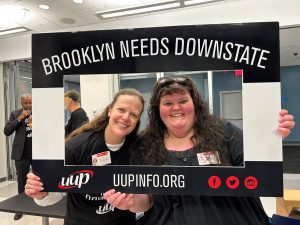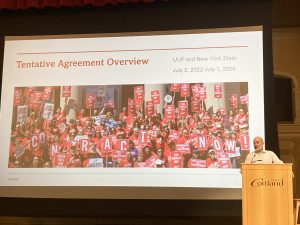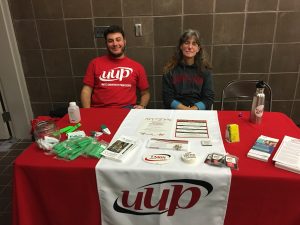Thousands gather by the state capitol Saturday, June 8th calling for a change in the state’s public school system.
Representing SUNY Cortland in pictures above – Left to Right: Nancy Kane, John Fracchia, Rickie McClure, Marc Dearstyne, John Driscoll, Kathy Lattimore, Jen Drake, Dave Ritchie and Bill Buxton.
Representing SUNY Cortland not pictured: Dave Ritchie, Kathy Lattimore, Jamie Dangler, Jo Schaffer, Anne Wiegard, Jim Ramsey, Ben Patrick, Kendal Patrick, Mario Hernandez, Dorothy Troike, Susana Davidenko and Maria Mandolesi.
ALBANY, N.Y. — The message was clear Saturday. The protesters — teachers, parents, students — said they’ve had enough.
“We need to do better. We need to do better for our kids,” said Joe Cantafio from the West Seneca Teachers’ Association.
Cantafio joined thousands from all over the state, calling for changes in the public education system.
“This is about making the Common Core work. More importantly, this is about access, things like quality, and issues like fair and equitable funding,” said Richard Iannuzzi, NYSUT president.
The driving force for many at the Capitol this weekend is the state’s emphasis on standardized testing.
“Students cannot be placed into a number,” said Cantafio.
Students grades three through eight took tests based on Common Core standards in April. Some students said they were not prepared for it.
“A lot of stuff on the tests were stuff I didn’t learn,” said 5th grader, Reilly Malloy.
Some teachers say they did not receive proper guidance from the state on how to implement the Common Core, which the state adopted in 2011.
“I think if the state is going to make demands and ask requirements, you can’t ask local districts to figure out those demands by themselves,” said Iannuzzi.
Teachers will be evaluated based on how students do on these tests. In fact, 40 percent of their evaluation will be based on standardized test scores. It’s a system many say is unfair.
“I can tell you that when you see students interacting in the classroom, that is much more indicative of their learning,” said Katie Ferguson, a 2nd grade teacher in Schenectady.
And, others called for investments in public education, specifically higher education.
“When I started in U. Albany, it was around 50% of the school’s budget came from state support. It’s down to around 18 percent. That’s a scary number,” said Thomas Hoey, vice president of U. Albany Professionals.
“This isn’t only about dollars. Getting it right is what will make the difference,” said Iannuzzi.




